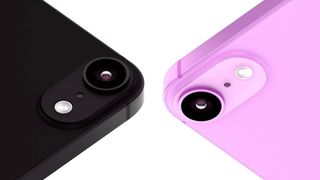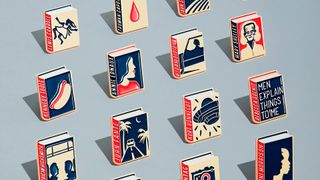Pentagram
In a special Design Icons feature, we focus not on an individual but on one of the best-loved and most respected design studios in the world. Garrick Webster heads out to West London to meet the partners who have helped make Pentagram great.
You never know what to expect when you visit a design studio. Is it going to be skinny jeans, hair gel and obscure music? Maybe a clean, stark setting with Swiss or Scandinavian dcor? In Pentagram's expansive London studio, everyone seems liberated from all the clichs of how designers should look and act. They design stuff - no contrivance.
The building is a converted dairy depot. Back in the day, milk floats rolled out of the gates and onto Needham Road at 4am each morning, delivering the white stuff to addresses across Notting Hill. Today, daylight streams in through the skylights into the first-floor studio, where various groups of designers are hard at work. Their graphics, product design and architectural projects might keep them here late into the night, but there's an unforced air of professionalism, alongside an undeniably light atmosphere. "Studious" is the word Domenic Lippa, who joined Pentagram as a partner in 2006 with a reputation in the fields of packaging, print, graphics and identity design, uses to describe it.
"Pentagram is, however, a very relaxed place to work, and I think that's due to the surfeit of space," adds fellow partner Angus Hyland, one of the UK's foremost graphic designers with over 100 design awards to his name. "We are very lucky in that we have inherited a wonderful building in which the amount of physical space alleviates the mental claustrophobia of tight deadlines."
Lippa and Hyland are two of seven London-based partners. There are 17 partners in total, the others being based in New York, Houston, San Francisco and Berlin. Disciplines vary from architecture and 3D design to graphics, digital and identity work. Daniel Weil joined in 1992 and is talented in architectural and 3D design, most recently working on the Archaeological Wing of the Israel Museum in Jerusalem. Harry Pearce has worked on projects for Boots, Saks Fifth Avenue and Williams F1. John Rushworth was a design consultant for Polaroid for 12 years and worked at Conran's before joining Pentagram in 1983. He was made a partner in 1989. Architect William Russell joined Pentagram as a partner in 2005 and has worked for the likes of Alexander McQueen, Krug Champagne, H&M and the Tate Gallery. Finally, Lorenzo Apicella brought his independent architectural practice into Pentagram and became a partner. He has worked for clients including the British Museum, the Natural History Museum, Millennium Dome, Citibank and Virgin Airlines.
The company was founded in 1972 with each partner autonomously running their own design team, working directly with clients. There are no CEOs, account managers or non-executive board members. Revenue is pooled to cover central staff costs, admin, maintenance and a chef, whose kitchen serves a delicious lunch menu for everyone at 1pm daily. Eating together is a Pentagram tradition.
As we explore the office, various designers are busy with identities, websites and posters, and one team is working up new bottle designs for a prestigious client. A slight buzz surrounds Harry Pearce's crew. They're preparing work for Witness, the human rights charity fronted by Peter Gabriel. A large format printer is whirring like a beehive, outputting posters for a fundraising dinner Pentagram is to host. Pearce has supported the charity for many years, contributing his design skills and winning awards in the process. Partners are free to pursue pro bono projects alongside their commercial work.
With a very horizontal company structure, the partners share profits and make key decisions together. There's plenty of collaboration - for instance, the Matter nightclub at the O2 employed William Russell's architecture alongside Angus Hyland's graphics - and some have likened Pentagram's democratic organisation to the ideals of a hippy commune.
"There is an element of radical idealism to the structure of Pentagram but it is far too hard-nosed about the realities of working in a commercial environment to be hippy," says William Russell in response to the suggestion. "The structure is designed with, hopefully, the same intelligence, craft and attention to detail that we put into everything we do."
All the London partners sit in alcoves along the back wall of the studio, and their teams sit in groups across the open-plan first floor, which is flooded with natural light. Each partner will work directly with clients and his team. "As all the partners are still practising designers rather than just fronting projects, it means we're all quite focused on the work," says Domenic Lippa. "The reason we're all here is the quality of the work; it's the primary reason why Pentagram has been so successful. None of us wants to look like we're doing sub-standard work next to each other, so it's a good way of keeping the output quality high."

Thank you for reading 5 articles this month* Join now for unlimited access
Enjoy your first month for just £1 / $1 / €1
*Read 5 free articles per month without a subscription

Join now for unlimited access
Try first month for just £1 / $1 / €1
Get the Creative Bloq Newsletter
Daily design news, reviews, how-tos and more, as picked by the editors.
The Creative Bloq team is made up of a group of design fans, and has changed and evolved since Creative Bloq began back in 2012. The current website team consists of eight full-time members of staff: Editor Georgia Coggan, Deputy Editor Rosie Hilder, Ecommerce Editor Beren Neale, Senior News Editor Daniel Piper, Editor, Digital Art and 3D Ian Dean, Tech Reviews Editor Erlingur Einarsson and Ecommerce Writer Beth Nicholls and Staff Writer Natalie Fear, as well as a roster of freelancers from around the world. The 3D World and ImagineFX magazine teams also pitch in, ensuring that content from 3D World and ImagineFX is represented on Creative Bloq.




